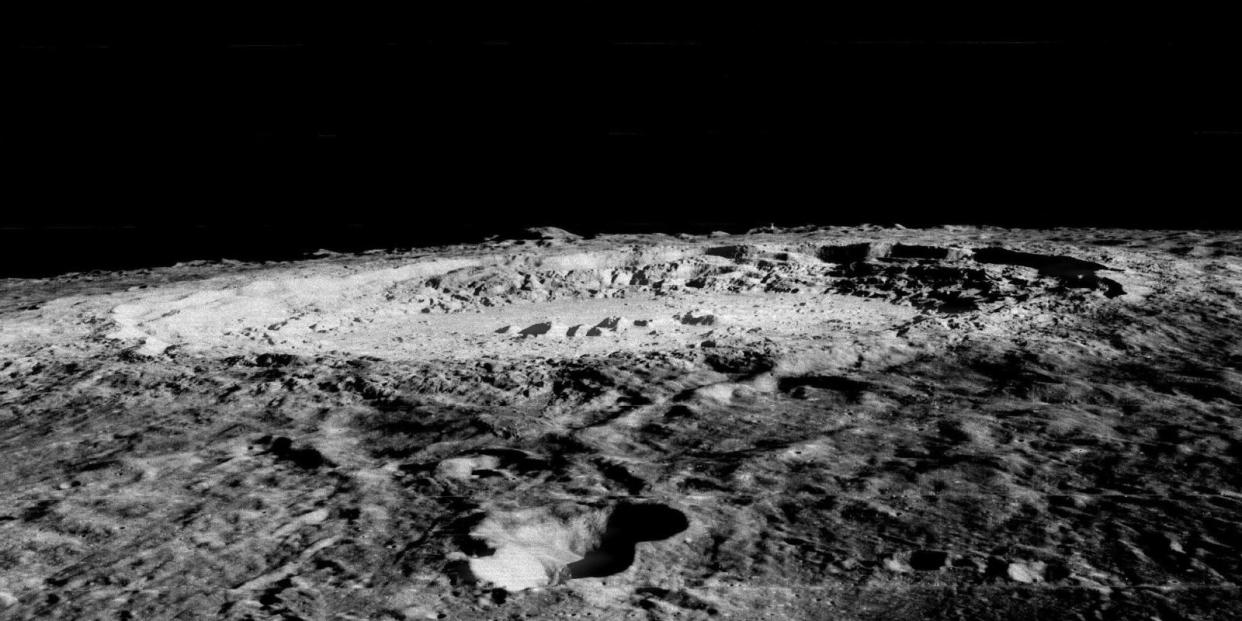Surface Water Seen Trapped in Rocks on the Moon

It seems we're always finding water on Mars-but a paper published in Nature Geoscience today reveals more space water much closer to home.
Using data from the Indian Space Research Organisation's (ISRO) Chandrayaan-1 lunar orbiter, two researchers from Brown University found something thought to be long gone: Water on the surface of the moon. But don't expect to go swimming anytime soon; it's trapped in rock.
The researchers specifically focused on pyroclastic rock, which is volcanic in origin. Samples returned from Apollo 15 and 17 showed an abundance of water trapped in glass "beads" within the rock, but researchers have since debated whether these rocks in particular were saturated with water for a unique reason or if all pyroclastic rocks on the moon develop these tiny pockets of water. It now seems that the evidence supports the latter, and pyroclastic rocks all over the moon contain notable stores of water.
"We saw that there were enhanced absorptions in the pyroclastic deposits but not in any of the surrounding terrains," says Ralph Milliken, a professor of planetary science at Brown University. "This was a key indicator that there was something different about these regions and that they were water-bearing relative to other nearby terrains."
Shuai Li, a graduate student at Brown and co-author on the paper, cautions that the water doesn't appear to be in an ice form, but rather is trapped in the minerals. Milliken and Li are also still trying to determine if it's actually hydrogen dioxide or or if it might be hydroxyl, a similar compound made of one hydrogen atom and one ionized oxygen atom. Whether it's water or hydroxyl "cannot be discriminated based on current satellite data," Li says.
There's no evidence that this finding is connected to ice deposits, and Li says that there's "definitely no" oceanic source of the water. But the water or hydroxyl does come from fairly deep below the lunar surface. "This water is inside the glass and originates from deep within the interior of the moon," Milliken says.
The water may be trapped in the lunar rocks, but that doesn't mean we can't use it. "The water signature seen in pyroclastic deposits has significant implications for future exploration of the moon," Li says. "Such water can be used as in situ resources."
Milliken agrees. "Our work shows that nearly all of these large deposits may also have water, and that is one of the most important resources that you would want to be able to have on the moon," he says. "Water is heavy and expensive to get from Earth to space, so any water that you can harvest on the moon gives you a huge advantage."
It also means that any future moon base may not have to rely as heavily on icy deposits at the poles away from the sun. Instead, it's possible to move to warmer latitudes based on the abundance of pyroclastic rock with glass beads of water instead.
"Water ice may be present in shadowed regions at the lunar poles, but the pyroclastic deposits may be much easier to access," Milliken says. "Though they don't have a lot of water in terms of weight percent there is a lot of this material, so it could be feasible to use it as a water resource."
"This is very similar to the mining process on Earth, extracting pure materials from low concentrations," adds Li.
So maybe we shouldn't overlook our big, bright neighbor so much when it comes to exploring the regions beyond Earth. Our only natural satellite still has plenty of surprises in store for us.
You Might Also Like

